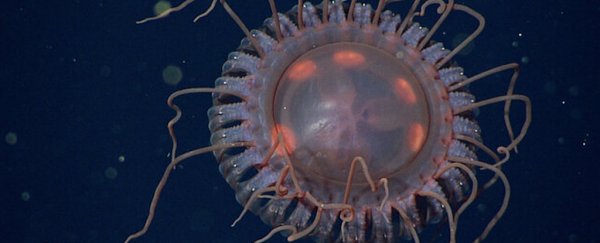In spite of years of research on various examples of deep-sea crown jelly known as Atolla, the genetic confirmation of a new species is now prompting biologists to redefine at least one of the genus's key characteristics or, perhaps, create an entirely new genus.
Descriptions of the freshly coroneted Atolla reynoldsi have zoologists from the Monterey Bay Aquarium Research Institute (MBARI) in the US thinking they might now need to invent a whole new branch of the family tree for it and some of the new species' closer relatives.
Also known as coronate medusa, Atolla are typically less than 10 centimeters (4 inches) across, blood-red in color, with a bell fringed with bumpy ridges and coiled tentacles, earning them their 'crowned' title.
The bioluminescent jellies are found in abundance far from sunlight in much of the world's marine waters. When biologists wanted to snap a shot of a giant squid last year, in fact, it was the signature flashing of one of these jellyfish they copied as a lure.
Keeping track of life above sea level is a hard enough job for biologists. But when an animal lurks hundreds of meters (thousands of feet) beneath the ocean's surface, it takes perseverance and technology to collect even the most basic details from the most common of benthic beasties.

MBARI has captured plenty of information on the characteristics of these dazzlingly beautiful animals in recent decades, thanks to their fleet of deep-sea research vessels.
Thanks to MBARI's efforts, 10 species have been formally assigned to the genus. Three stand out as easy to distinguish, while the rest take an expert eye to tell apart.
But one thing biologists thought they could rely on as an Atolla signature trait was a single, super-long tentacle that trailed from its coif of curls.
Stretching up to six times the diameter of its bell, these appendages are thought to be a tool for snagging ghostly threads of 'stingy thingy' siphonophores that float about in the open seas.
In the past 15 years, however, three types of Atolla have occasionally been spotted without a distinguished tentacle, leaving researchers scratching their heads over the reliability of their checklist for classifying some of the more ambiguous examples of these animals.
The official recognition of Atolla reynoldsi as a genetically distinct species means its own unique characteristics – including its relatively large size of around 13 centimeters – either need to be considered features of the existing genus or considered part of a new genus altogether.
It's a decision biologists regularly face as new specimens – both extant and extinct – come to light, throwing into question the usefulness of existing boundaries between branches of life.
With two more potential novel species of the crowned jellyfish waiting evidence for classification, it might soon be time for a new line of royalty to blossom in our ocean's depths.
"These remarkable new jellies underscore how much we still have to learn about the deep sea," says MBARI Senior Education and Research Specialist George Matsumoto.
"On just about every dive into the depths of Monterey Bay, we learn something new."
This research was published in Animals.
